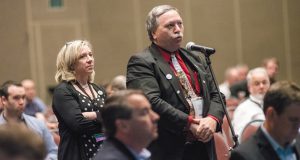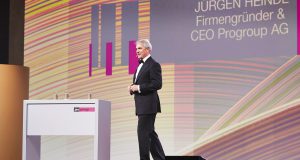Södra Cell’s Värö mill faced a number of challenges during an expansion project unlike any other in the industry. The results? The mill is now hitting its targets and offering more choice for customers.
MARK RUSHTON
In 2014, Swedish market pulp giant Södra Cell decided to make big investments at all three of its mills—Värö, Mörrum, and Mönsterås— as part of a strategy of growing in line with its customers. The major expansion project carried out at the Värö mill in southern Sweden started up at the end of last year.

Södras massabruk i Värö
The Värö expansion has increased the pulp capacity at the mill from 425,000 tpy to 700,000 tpy of softwood sulphate pulp (NBSK), which makes it one of the world’s largest of its kind. In addition to increased pulp production, a major investment in energy production was made that now sees the mill generating 800 GWh compared with 400 GWh before the expansion. Södra says this means there is an ongoing excess of 400 GWh, which has increased its deliveries of green energy to the Swedish national grid dramatically.
The expansion project was extensive and across the whole mill, including a new chip plant, digester with a capacity of 2,500 tpd (currently the world’s largest long-fiber digester), screening and washing, oxygen bleaching, a new dryer, evaporation, a new recovery boiler and turbine. There were also added investments in causticization and water purification.
The official inauguration of Värö took place in the latter part of 2016, and the mill is now up and running and on schedule with the original start-up curve forecast. However, there were challenges to overcome, as the mill continued running at full capacity during the expansion.
Marcus Hellberg, head of marketing and business development at Södra Cell, says of the project, “It’s been a great success on several levels. We’re very proud of the fact that the new line was built while the old line was still running. This is possibly a first for the industry—to run a mill of this scale in parallel with such a large reconstruction is not the norm. And we actually hit an all-time high production level during this period, which is quite an achievement.
“Employing thousands of contractors and suppliers inside a working mill was a huge challenge in terms of security and logistics. Overall, it was a feat of organization and planning. However, the fact that we did suffer a fatality

Invigning av Södras massabruk i Värö. Fr.v. Jonas Eriksson, Platschef Södra Cell Värö, H.M. Konung Carl XVI Gustaf, Lars Idermark,
Koncernchef i Södra. ENG: Inauguration of Södra Cell Värö. From the left: Jonas Eriksson, Mill manager, Södra Cell Värö, H.M. King Carl XVI Gustaf, Lars Idermark, CEO of Södra.
during construction is deeply regretted by everyone involved and for that reason, of course, we cannot say the process was perfect.”
And how are production levels now, and progress toward achieving design speed? “Production targets for 2016 were not fully met, largely because installation was delayed, causing the mill to start up five weeks behind schedule. However, the plan was never to ramp up to full capacity by the end of 2016. This year is really the ramp-up year, and we will be at full design capacity of 700,000 metric tons by the end of 2017, in line with our plan.”
Aside from the initial hitch of starting up later than expected, Södra says it is now following its predicted start-up curve accurately.
“Targets are always hard to set,” says Hellberg, “but we simulate our production numbers based on data collected from similar start-up projects, both brownfield and greenfield, and so far, it’s proving accurate. While production numbers are of course important, the emphasis now is on making sure we continue to tweak the quality to the optimum level.”
AN EXPANDED PRODUCT PORTFOLIO
Obviously, in the demanding world of pulp, quality and choice are key as well as being able to supply the required tonnage. What difference has the project made to customer choice? Hellberg says, “Värö’s expansion means that we can now offer our customers a larger volume of high-quality Nordic NBSK sourced from a secure, sustainable raw material base—our members’ forests. This provides peace of mind for customers, both on availability and sustainability.
“We will also be able to offer them an expanded product portfolio. We are currently running ECF trials with a view to offering both ECF and TCF grades. In addition, we’ve increased our capacity of flash-dried pulps. These have high porosity and are high-value grades, especially appreciated in the specialty sector—for filters, for example.”
From Södra’s point of view, the NBSK market is looking healthy. Hellberg says outlook for the grade is bright and right now the focus is on consolidating its position as one of the world’s leading suppliers of the softwood grade. “Now is the time to concentrate on really optimizing quality and showing the world what this state-of-the-art mill can do. We don’t have any further plans in terms of adding capacity. The immediate future will see a period of consolidation and fine-tuning to get the best out of the investment.”
LESSONS LEARNED?
Major, ambitious projects such as the one embarked on at Värö are always challenging, and as the saying goes, “every day is a school day.” What lessons, if any, have been learned during this project? Hellberg concludes, “Overall, our vision and plans for the project have proved extremely accurate. That said, a project of this magnitude always throws up challenges you can neither foresee nor plan for. The trick is to be flexible and adapt as the situation  dictates, and mill manager Jonas Eriksson and his team certainly did just that.
dictates, and mill manager Jonas Eriksson and his team certainly did just that.
“The planning for a project like Värö was extremely complex and involved, coordinating thousands of people from different companies. You simply cannot control everything every minute. And Sweden’s weather adds a degree of uncertainty all on its own,” says Hellberg. “A mill is like a living organism, one minute feeling fine and the next it can suffer a hiccup. Overall, we’re extremely pleased with the outcome.”
Värö Scope of Supply
The main supplier for the SEK 4 billion project (US$458 million) was Valmet, supplying the new fiber line, digesting plant, rebuilding the drying machine and baling lines, reconstruction and completion of evaporation, recovery boiler, and causticization.
Other suppliers included Doosan Skoda for the new condensing turbine; Raumaster for the chip stock, chip conveyers and screening station; Veolia Water for the biological wastewater treatment plant; and Akzo Nobel for the dioxide plant.
For electricity and automation, ABB supplied control systems and drives and Vacon supplied the AC drives.
The major expansion at Södra Cell’s Värö mill has increased the pulp capacity from 425,000 tpy to 700,000 tpy.
The new line was built while the old line was still running—a rare achievement.
Left: H. M. King Carl XVI Gustaf of Sweden was in to plant a tree at the Värö pulp mill’s official inauguration.
Below from left: Jonas Eriksson, manager Södra Cell Värö; H. M. King Carl XVI Gustaf of Sweden; Lars Idermark, CEO of Södra.
Marcus Hellberg, head of marketing and business development at Södra Cell.
 Paper 360
Paper 360


